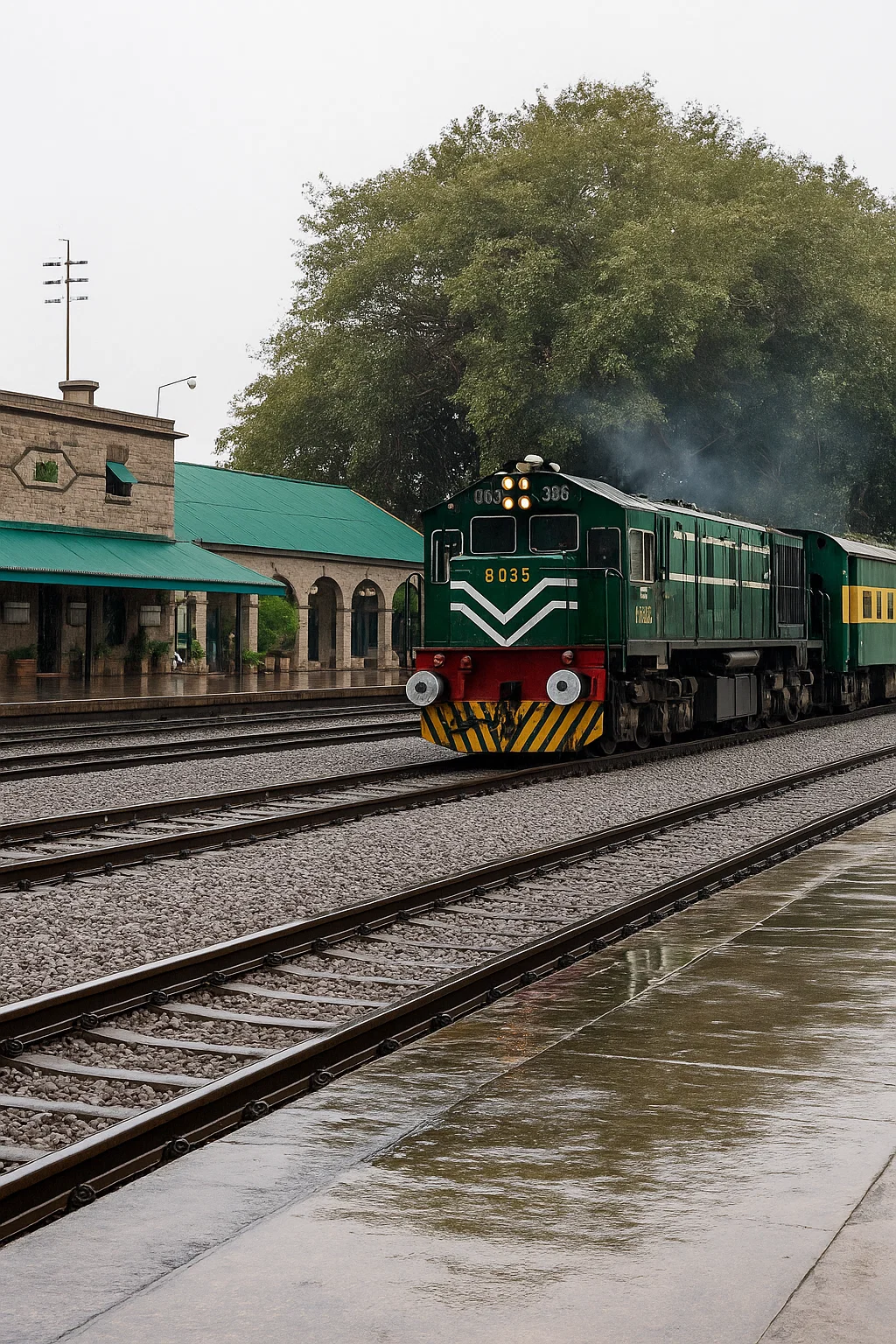For decades, Pakistan Railways has been considered the backbone of the country’s transport and logistics network. From connecting major cities to transporting goods across provinces, the railway system has played a vital role in shaping the nation’s economic and social fabric. However, over the years, Pakistan Railways faced severe challenges — outdated infrastructure, financial mismanagement, lack of investment, and stiff competition from road transport. As a result, the once-thriving network gradually fell behind in both efficiency and reliability.
Today, that scenario is changing. With the support of the Asian Development Bank (ADB), a fresh wave of investment is breathing new life into Pakistan Railways. This financial boost is aimed at modernizing infrastructure, improving safety, enhancing freight and passenger services, and ensuring that Pakistan Railways can once again meet the needs of a growing economy.
In this article, we’ll explore seven key ways ADB’s investment is putting Pakistan Railways back on track, while also highlighting the challenges that lie ahead.
ADB’s Investment in Pakistan Railways
The Asian Development Bank has long been a partner in Pakistan’s development projects, ranging from energy and education to infrastructure. Its recent commitment to Pakistan Railways marks a turning point in the country’s transportation history.
The investment focuses on:
-
Upgrading railway tracks and signaling systems
-
Enhancing safety standards
-
Expanding freight operations
-
Introducing modern locomotives and passenger carriages
-
Promoting sustainable and green transportation solutions
This comprehensive plan not only improves day-to-day operations but also strengthens the long-term viability of Pakistan Railways. By combining financial resources with technical expertise, ADB aims to transform Pakistan Railways into a reliable, efficient, and modern transport system.
7 Ways ADB Investment Puts Pakistan Railways Back on Track
1. Modernization of Railway Infrastructure
One of the most visible impacts of ADB’s investment is the modernization of Pakistan Railways’ infrastructure. Decades of underfunding had left tracks, bridges, and stations in poor condition, causing frequent delays and accidents.
With fresh funding, outdated tracks are being replaced with stronger, high-speed rail-compatible ones. Bridges are undergoing rehabilitation to ensure safety and durability, while passenger stations are being upgraded with modern amenities. This modernization drive enhances not just the reliability of Pakistan Railways, but also the travel experience for millions of passengers.
READ MORE:
https://freedompakistan.com.pk/
2. Safer and Faster Train Operations
Safety has long been a concern for Pakistan Railways, with outdated signaling systems and poorly maintained equipment often blamed for accidents. ADB’s funding is specifically targeting this weakness by introducing advanced digital signaling systems, automated controls, and monitoring technologies.
These upgrades mean trains can run at faster speeds without compromising safety. For passengers, this translates into shorter travel times, and for freight customers, quicker deliveries. Improved safety also boosts confidence in Pakistan Railways, encouraging more people and businesses to rely on the system.
3. Boosting Freight Capacity
Freight services are a critical revenue source for Pakistan Railways, yet the sector has been underutilized due to inefficient operations and competition from road transport. ADB’s investment is helping to expand freight capacity by upgrading cargo terminals, introducing specialized freight trains, and improving logistics systems.
With these improvements, Pakistan Railways is expected to handle larger volumes of goods such as cement, coal, agricultural products, and consumer goods. This reduces the pressure on highways, cuts transportation costs for businesses, and boosts the country’s economic productivity.
4. Reducing Travel Time for Passengers
One of the major reasons passengers abandoned Pakistan Railways in favor of buses or private vehicles was the long travel times. Delays caused by old tracks, outdated locomotives, and frequent breakdowns frustrated passengers.
Thanks to ADB’s support, newer locomotives and upgraded tracks are enabling trains to run at higher speeds with fewer interruptions. Routes connecting major cities like Karachi, Lahore, Islamabad, and Peshawar are being prioritized to drastically reduce travel time. The revival of fast and efficient passenger services could mark a return of rail as the preferred mode of intercity transport in Pakistan.
5. Promoting Green and Sustainable Transport
Environmental sustainability is becoming increasingly important worldwide, and Pakistan Railways is no exception. Traditionally, trains are more energy-efficient than road transport, but Pakistan’s reliance on outdated diesel locomotives had eroded this advantage.
ADB is investing in energy-efficient locomotives that consume less fuel and emit fewer pollutants. Over time, the transition toward hybrid or electric systems could make Pakistan Railways one of the greenest modes of mass transportation in the country. This not only benefits the environment but also helps reduce Pakistan’s reliance on costly imported fuel.
6. Generating Employment Opportunities
Infrastructure projects of this scale inevitably create thousands of jobs. From construction workers upgrading tracks and bridges to engineers designing signaling systems, the modernization of Railways is fueling significant employment opportunities.
Beyond direct jobs, there are indirect benefits too. More efficient freight services will support industries across Pakistan, while better passenger connectivity will encourage tourism and local business growth. This ripple effect ensures that ADB’s investment in Pakistan Railways supports the broader economy, not just the transport sector.
7. Strengthening Economic Connectivity
Railways are not just about transport—they are about connectivity. For a country like Pakistan, where trade routes are critical to economic growth, Pakistan Railways can play a transformative role.
ADB’s investment aims to strengthen both domestic and regional connectivity. Domestically, better links between provinces will improve the movement of people and goods, promoting unity and growth. Regionally, modern rail links can position Pakistan as a key trade corridor, particularly under initiatives like the China-Pakistan Economic Corridor (CPEC). With efficient railway infrastructure, Pakistan could become a hub for regional trade and logistics.
Challenges Ahead for Pakistan Railways
While ADB’s investment is a huge step forward, challenges remain. Some of the most pressing issues include:
-
Corruption and Mismanagement: Long-standing governance issues have plagued Pakistan Railways, leading to inefficiencies and financial losses. Without transparency, even significant investments may not yield the desired results.
-
Maintenance Culture: Upgraded infrastructure requires regular maintenance. Building a culture of timely repairs and proactive management is essential.
-
Political Interference: Frequent changes in leadership and politically motivated decisions have historically undermined progress. Sustained reforms are needed to ensure continuity.
-
Financial Sustainability: Ticket prices, freight charges, and subsidies must be carefully managed to ensure that Pakistan Railways can operate profitably in the long term.
Addressing these challenges will determine whether ADB’s investment truly transforms Pakistan Railways into a world-class system.
Conclusion
The revival of Pakistan Railways is not just about trains—it’s about national progress. With ADB’s investment, the system is finally getting the financial and technical push it desperately needed. From modern infrastructure and safer operations to increased freight capacity and sustainable transport, the changes underway are significant.
If managed properly, this could mark the beginning of a new era where Pakistan Railways once again becomes the backbone of the country’s economy. However, success will depend on transparency, accountability, and long-term vision.
For now, the tracks are being laid for a brighter future. Thanks to ADB’s timely support, Pakistan Railways is truly back on track.












